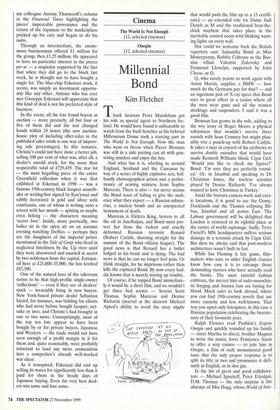Salerooms
Dealers' dilemma
Susan Moore
What do you do if five days before the sale of your property at auction, a third party steps forward and offers you double the auction estimate? Discreet withdrawal is impossible: the property has been widely publicised, given its own hardback cata- logue and dispatched on a global tour. The stakes are raised higher still when the third party learns of the £250,000 penalty payable to the auction house if the contract is broken, and offers to pay that too.
This was the dilemma that faced Lon- don-based Eskenazi Ltd, probably the world's pre-eminent dealers in Chinese works of art, the residual stock of whose dormant Japanese department was con- signed for auction at Christie's last week. This disposal of the firm's 100 best exam- ples of lacquer, netsuke and inro — and, indeed, the closure of the department — follows the death three years ago of Giuseppe Eskenazi's brother-in-law, Luigi Bandini, who had run the department since 1976, and the decision made last year by his widow, Rosemary, to leave the company to set up business on her own. There was no one left in the firm who knew the clients or the market.
Most of the pieces — including a group of lacquer boxes of exceptional quality and condition — had come from some of the greatest Japanese art collections ever made in the West. The reason why these pieces had not already been sold, the firm candid- ly explained, was that they had probably been asking too much money for them. Now, it was widely reported, they just wanted the pieces to sell — and estimates were set accordingly. If the pieces sold on their estimates, the firm, buying in the boom years of the Eighties, would make a loss. At this point, one particular reader of
my colleague Antony Thorncroft's column in the Financial Times highlighting the pieces' impeccable provenance and the return of the Japanese to the marketplace pricked up his ears and began to do his sums.
Through an intermediary, the anony- mous businessman offered £1 million for the group, then £1.25 million. He appeared to have no particular interest in the pieces per se — a suspicion supported by the fact that when they did go to the block last week, he is thought not to have bought a single lot. The blue-chip Eskenazi stock, it seems, was simply an investment opportu- nity like any other. Anyone who has ever met Giuseppe Eskenazi will appreciate that this kind of deal is not his preferred style of business.
In the event, all the lots found buyers at auction — more precisely, all but four or five of them did and the rest changed hands within 24 hours (the new auction- house ploy of including after-sales in the published sales totals is one way of improv- ing sale percentages). In this instance, Christie's could not have done a better job, selling 100 per cent of what was, after all, a dealer's unsold stock, for the more than respectable total of £729,439. The star lot — the most beguiling piece of the entire Greenfield collection when it was first exhibited at Eskenazi in 1990 — was a famous 19th-century black lacquer suzurib- ako or writing-box signed by Kan'yosai and subtly decorated in gold and silver with courtesans, one of whom is writing onto a screen with her mouth — spitting or maybe even licking — the characters meaning 'secret love'. Inside, more poetically, two ladies sit in the open air on an autumn evening watching fireflies — perhaps they are the daughters of the imperial prince mentioned in the Tale of Genii who lived in neglected loneliness by the Uji river until they were discovered and courted in secret by two noblemen from the capital. Estimat- ed here at £25,000-35,000, the box fetched £87,300.
One of the natural laws of the saleroom seems to be that high-profile single-owner 'collections' — even if they are of dealers' stock — invariably bring in new buyers. New York-based private dealer Sebastian Izzard, for instance, was bidding for clients who had never before bought lacquer, net- suke or inro, and Christie's had brought in one or two more. Unsurprisingly, most of the top ten lots appear to have been bought by or for private buyers, Japanese and Western — the trade would not have seen enough of a profit margin in it for them and, quite reasonably, were probably reluctant to load any more ammunition into a competitor's already well-stocked war chest.
As it transpired, Eskenazi did end up selling its wares for significantly less than it paid for them in the heady days of Japanese buying. Even the very best deal- ers win some and lose some.



























































































 Previous page
Previous page